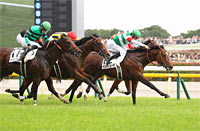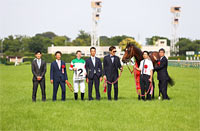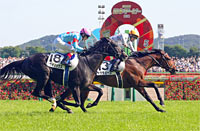Tokyo Yushun (Japanese Derby) (G1) - Data Analysis
Ultimate contest for three-year olds watched with great interest by horsemen at home and abroad
Shahryar, who dominated the Tokyo Yushun (Japanese Derby) in 2021, went on to secure his first overseas G1 victory in the 2022 Dubai Sheema Classic. Equinox, who finished second in the 2022 Japanese Derby, similarly won the Dubai Sheema Classic in March of this year, and was the highest rated horse in the Longines World’s Best Racehorse Rankings from January 1 to April 9, 2023. In addition to being the generational champion decider of the year, the Japanese Derby is likely to attract attention not only in Japan but also in many other countries around the world. Let’s now analyze some features shared by successful runners in this race based on results over the last 10 years.
Solid performance by runners that have performed well in either a middle-distance graded race held in the Kanto area or the Kyoto Shimbun Hai
Of the 30 Top 3 finishers over the last 10 years, 24 had experience of finishing in the Top 3 of “a graded race run over a distance of more than 1,600m but below 2,400m at Tokyo Racecourse or Nakayama Racecourse.” Conversely, runners without such experience struggled with a Top 3 ratio of 6.6%. It is therefore probably a good idea to focus on runners that have finished in the Top 3 of a middle-distance graded race held in the Kanto area. [Table 1]
[Table 1] Performance by experience of finishing in the Top 3 of “a graded race run over a distance of more than 1,600m but below 2,400m at Tokyo Racecourse or Nakayama Racecourse” (last 10 years)
| Experience |
Performance
[1st-2nd-3rd-4th or lower] |
Win ratio |
Top 2 ratio |
Top 3 ratio |
| Yes |
8-9-7-63 |
9.2% |
19.5% |
27.6% |
| No |
2-1-3-85 |
2.2% |
3.3% |
6.6% |
In addition, among the six Top 3 finishers without experience of finishing in the Top 3 of “a graded race run over a distance of more than 1,600m but below 2,400m at Tokyo Racecourse or Nakayama Racecourse,” three had experience of “winning or finishing in second or lower without any time difference with the winner” in the Kyoto Shimbun Hai. Runners without such experience had a Top 3 ratio of only 3.7%. In other words, we should raise our expectations of runners that have triumphed, or finished second or lower without any time difference with the winner in the Kyoto Shimbun Hai. [Table 2]
[Table 2] Among runners without experience of finishing in the Top 3 of “a graded race run over a distance of more than 1,600m but below 2,400m at Tokyo Racecourse or Nakayama Racecourse,” performance by experience of “winning, or finishing in second or lower without any time difference with the winner” in the Kyoto Shimbun Hai (last 10 years)
| Experience |
Performance
[1st-2nd-3rd-4th or lower] |
Win ratio |
Top 2 ratio |
Top 3 ratio |
| Yes |
2-1-0-6 |
22.2% |
33.3% |
33.3% |
| No |
0-0-3-79 |
0% |
0% |
3.7% |
Poor showing by runners coming straight from a major defeat
Of the 30 Top 3 finishers over the last 10 years, 27 had finished first, or second or lower with a time difference of 0.5s or less with the winner in their previous race. Conversely, runners that had finished second or lower with a time difference of 0.6s or more with the winner in their previous race struggled with a Top 3 ratio of 4.3%. This suggests we should lower our expectations of runners coming straight from a major defeat. [Table 3]
[Table 3] Performance by finish in the previous race and time difference with the winner in that race (last 10 years)
| Finish in previous race and time difference with winner in that race |
Performance
[1st-2nd-3rd-4th or lower] |
Win ratio |
Top 2 ratio |
Top 3 ratio |
1st, or 2nd or lower with time
difference of 0.5s or less with winner |
9-10-8-80 |
8.4% |
17.8% |
25.2% |
2nd or lower with time difference of
0.6s or more with winner |
1-0-2-67 |
1.4% |
1.4% |
4.3% |
| Pulled up |
0-0-0-1 |
0% |
0% |
0% |
Favoritism in previous race also a key factor
Of the 30 Top 3 finishers over the last 10 years, 21 had been backed as 3rd favorite or higher in their previous race. Conversely, runners that had been backed as 4th-9th favorite achieved a Top 3 ratio of only 12.5%, and runners that had been backed as 10th favorite or lower were all beaten to 4th or lower. When comparing the previous race of the runners, we should check their favoritism in that race. [Table 4]
[Table 4] Performance by favoritism in the previous race (last 10 years)
| Favoritism in previous race |
Performance
[1st-2nd-3rd-4th or lower] |
Win ratio |
Top 2 ratio |
Top 3 ratio |
| 3rd favorite or higher |
8-9-4-48 |
11.6% |
24.6% |
30.4% |
| 4th-9th favorite |
2-1-6-63 |
2.8% |
4.2% |
12.5% |
| 10th favorite or lower |
0-0-0-37 |
0% |
0% |
0% |
Focus on runners with “6 or fewer” career starts
Of the 30 Top 3 finishers over the last 10 years, 27 had six or fewer career starts. Conversely, runners with seven or more career starts struggled with a Top 3 ratio of 5.7%. If we limit our analysis to the seven years since 2016, their performance was [0-0-0-25] (Top 3 ratio of 0%). We therefore probably need to discount runners with seven or more career starts. [Table 5]
[Table 5] Performance by total career starts (last 10 years)
| Total career starts |
Performance
[1st-2nd-3rd-4th or lower] |
Win ratio |
Top 2 ratio |
Top 3 ratio |
| 6 or fewer |
9-9-9-98 |
7.2% |
14.4% |
21.6% |
| 7 or more |
1-1-1-50 |
1.9% |
3.8% |
5.7% |
Runners that led the pack last time out have had a slight edge in recent years
Of the 12 Top 3 finishers over the last four years, eight had been positioned fifth or higher when passing the 4th corner in their previous race. Conversely, runners that had been positioned sixth or lower struggled somewhat with a Top 3 ratio of 10.3%. If trends in recent years are anything to go by, we should raise our expectations of runners that led the pack in their previous race. [Table 6]
[Table 6] Performance by position when passing the 4th corner in the previous race (last four years)
| Position when passing 4th corner in previous race |
Performance
[1st-2nd-3rd-4th or lower] |
Win ratio |
Top 2 ratio |
Top 3 ratio |
| 5th or higher |
2-4-2-23 |
6.5% |
19.4% |
25.8% |
| 6th or lower |
2-0-2-35 |
5.1% |
5.1% |
10.3% |
| Pulled up |
0-0-0-1 |
0% |
0% |
0% |
In addition, three of the four runners that finished in the Top 3 despite being positioned sixth or lower when passing the 4th corner in their previous race, had contested the Satsuki Sho (Japanese 2000 Guineas) in their previous race and been ranked second or higher in the estimated time over the final three furlongs. This suggests we should lower our expectations of runners that were positioned sixth or lower when passing the 4th corner in their previous race with the exception of runners that were ranked second or higher in the estimated time over the final three furlongs in the Satsuki Sho. [Table 7]
[Table 7] Among runners that had been positioned sixth or lower when passing the 4th corner in their previous race, performance by the previous race and ranking in terms of the estimated time over the final three furlongs in that race (last four years)
Previous race and ranking in terms
of estimated time over final three
furlongs in that race |
Performance
[1st-2nd-3rd-4th or lower] |
Win ratio |
Top 2 ratio |
Top 3 ratio |
| Satsuki Sho, and ranked 2nd or higher in estimated time over final three furlongs |
2-0-1-3 |
33.3% |
33.3% |
50.0% |
| Other than the Satsuki Sho, or ranked 3rd or lower in estimated time over final three furlongs |
0-0-1-32 |
0% |
0% |
3.0% |
Seek out the winner!
Distance and closing speed in previous race can be useful statistics
The last 10 winners had all run a 1,800-2,200m race in their previous race, and had been ranked fifth or higher in the estimated time over the final three furlongs in that race. Runners coming from races with a distance of 1,600m or less or 2,400m or more, and those ranked sixth or lower in the estimated time over the final three furlongs in their previous race should be viewed as unlikely to pull off a victory. Another shared feature among the 10 winners was that they had all been backed as 5th favorite or higher in their previous race. We should therefore also focus on the trend shown in Table 4. [Table 8]
[Table 8] Winner’s performance by distance of the previous race, ranking in terms of estimated time over the final three furlongs last time out, and favoritism in the previous race (last 10 years)
| Year |
Winner |
Distance of previous race |
Ranking in terms of estimated time over final three furlongs last time out |
Favoritism in previous race |
| 2013 |
Kizuna |
2200m |
1st |
1st favorite |
| 2014 |
One and Only |
2000m |
1st |
4th favorite |
| 2015 |
Duramente |
2000m |
1st |
3rd favorite |
| 2016 |
Makahiki |
2000m |
1st |
3rd favorite |
| 2017 |
Rey de Oro |
2000m |
2nd |
5th favorite |
| 2018 |
Wagnerian |
2000m |
5th |
1st favorite |
| 2019 |
Roger Barows |
2200m |
3rd |
2nd favorite |
| 2020 |
Contrail |
2000m |
1st |
1st favorite |
| 2021 |
Shahryar |
1800m |
2nd |
2nd favorite |
| 2022 |
Do Deuce |
2000m |
1st |
1st favorite |
(Masaya Ibuki)
|




















